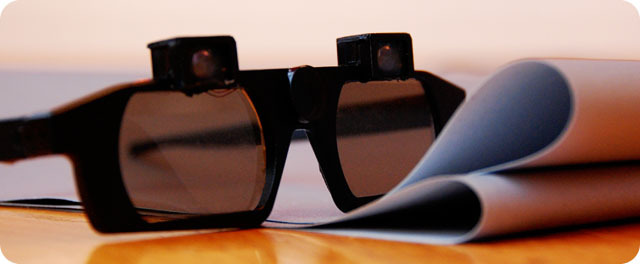We are truly standing on the precipice of a cyberpunk future, and I, for one, welcome our new technocratic overlords who are promising to bring us augmented- and virtual-reality vision.
Technical Illusions is a new company founded by former Valve Software employees Jeri Ellsworth and Rick Johnson. They are working on a device called CastAR that is capable of augmenting reality and immersing a player in virtual reality.
Valve cut Ellsworth’s and Johnson’s positions in February, but the pair continued their work on the CastAR that they began while working for Valve head honcho Gabe Newell. Now, they are attempting to raise $400,000 through a crowdfunding project on Kickstarter to turn their concept into a consumer product.
A few hours into the campaign, backers already contributed more than $80,000.
Augmented reality is the concept of layering game and video data and images over the real world. Certain smartphone apps and games use AR to make it look like enemies are zooming around the player’s environment.
CastAR is essentially a pair of glasses bundled with a variety of sensors and a pair of tiny projectors (one above each eye). This combination of technologies is capable of a few eye-shattering feats:
Those face-mounted projectors can display an interactive play field onto a surface. The glasses use existing 3D technology — the same kind used on some 3D televisions — to give the image depth. Simultaneously, sensors can track head motion so that the projection changes the perspective of the image. This means that CastAR can create interactive Dugneons & Dragons maps where each player sitting around a tablet can see a unique angle of the environment.
That covers the AR capabilities, but CastAR is also a VR solution. Technical Illusions accomplishes this by attaching a clip-on peripheral to the glasses that directs the images of the projectors over a player’s eyes.
The company explains how it all works in its Kickstarter pitch video below:
To get all of the AR and VR functionality, backers need to contribute at the $285 level. This creates a little bit of competition for Oculus VR’s Rift headset.
Oculus Rift is a face-mounted display that also uses head-tracking sensors to create a 3D virtual-reality experience for gamers. Unlike CastAR, Oculus puts the screen directly in front of the eyes rather than directing projects that sit above them. This means Oculus doesn’t have any AR features.
CastAR is playing in different markets than Oculus. Technical Illusions is focusing on the augmented-reality capabilities, which the Oculus isn’t built for, but that doesn’t mean CastAR cannot jump out in front of the VR market and potentially steal Oculus Rift’s momentum.
With Oculus VR and Technical Illusions, virtual reality seems like it is on the verge of breaking out into a major consumer-electronics category. The two startups are establishing that the technology is at a point where players can feel totally enveloped by a game world, now they just need to prove they can make money doing it.
VentureBeat's mission is to be a digital town square for technical decision-makers to gain knowledge about transformative enterprise technology and transact. Learn More

